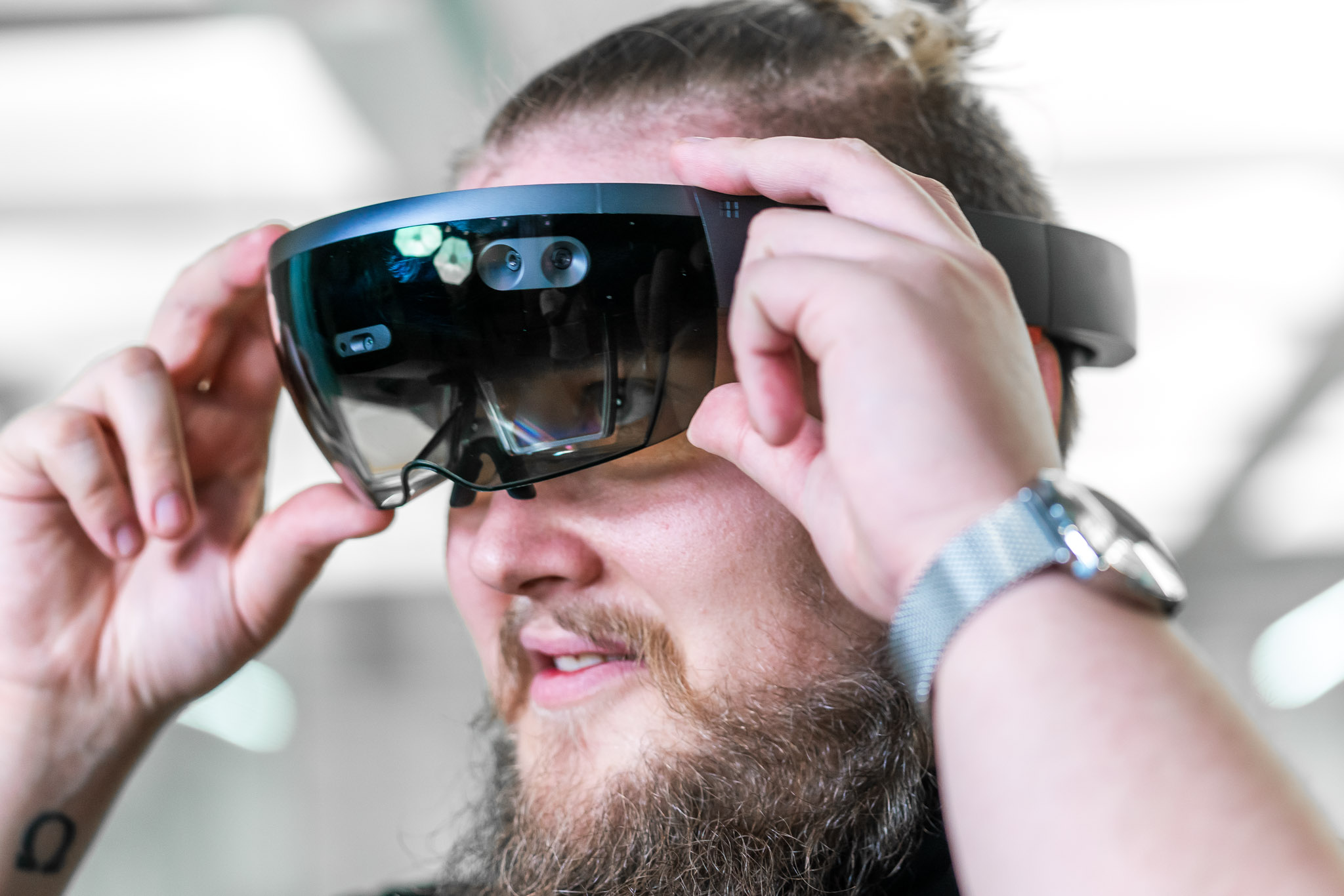Not everything needs to be cancelled this Spring. There are many ways to collaborate remotely, even when it comes to the messy, explorative, participative parts. Tools and practices may need to adapt, but the core of creative work is still the same.
As experts in facilitation and design, we help customers in their service and business transformations, teaming up with our clients and closely collaborating with end-users. In a normal situation, it’s most often a combination of on-site and remote work. While physical offices have never been this empty, teams keep on delivering by working together from across a distance. We collected some thoughts and experiences on how remote teams can manage these new circumstances.
Creating collaborative spaces
One of the most widely adopted ideas of Design Thinking, aside from the double-diamond approach, must be the war-room with swarms of post-its on walls. This manifestation of innovation is a signal to everyone around: it is where the magic happens. Finding the best ways to present information is an integral skill of any designer, and seeing bits and pieces of insight literally come together can be a very important phase of the process. From detective ‘crazy walls’ in TV series to decoding a customer journey, visual representations play a big part in problem solving.
Any given design project is also likely to have points when people gather in the same space at the same time, sharing experiences and ideas, voting, synthesizing or drafting solutions together. Facilitating workshops is what the trade of Service Design is perhaps best known for. There are plenty of good reasons to favor face-to-face time: establishing trust and empathizing, for instance, happens more naturally when we can also use nonverbal communication.
For a large part, the work we do is not necessarily finding one correct answer, but learning new ways to collect, process and act upon information. When we analyze insight together and collaborate on ideas, we are building a shared understanding of the world around us and its possibilities. So, how do we create a sense of working together, when we are working apart?
It’s less about tools and more about facilitation
Our designers recently had a chat about building collaborative spaces online. We quickly concluded that digital tools are not a shortcut to happiness, yet taking advantage of their possibilities is wise. The best online tools not only help replace physical facilities and exercises, but bring value we couldn’t gain using analogue ways of working.
Version control and digital whiteboards let us work simultaneously on many different parts of a design, sketching or prototyping without having to send documents back and forth. We have good experiences with tools like Abstract and Sketch Cloud for version control, and Figma for both this and shared workspaces for teams. Digital whiteboards such as Google Jamboard, Miro and InVision Freehand are also in good use with many of our projects, providing places to collaborate in more or less structured ways, depending on how you set the boards up.
Some collaboration platforms have advanced features for research and analysis. Userbit helps manage and synthesize interview and survey data, or collaborate building personas, user journeys and other design tools. Howspace uses machine learning to analyze ideas and comments, providing sentiment analysis, summaries and highlights of interesting points instantly. A good guideline to organizing virtual work in the longer term is to build practices that make use of the tools and harness the potential of technology too, instead of just aiming to carry out familiar activities over video conferences.
As with all the work we do with our customers, technology is an enabler but not the solution itself. Choosing or building software to fit your needs is important, and Siili’s consultants actively test and use various platforms to be able to help our customers select and create ones that bring most value to their exact situation.
But no matter the tools you select and learn to use, the biggest point to pay attention to is how your teams across the organization find ways of working together. Even if your organization has strict policies and only uses a small range of tools, just using the Microsoft Office Suite smartly has lots of opportunities to organize collaboration. In our recent discussion, three main themes emerged from experiences in guiding remote teamwork, with a heightened need for:
1) carefully ensuring all voices are being heard,
2) a calm pace and the possibility to participate in your own time,
3) clear instructions, rules and training.
“I hear you”
With people joining video calls from many different locations, remote connections are sometimes tricky. All of us have kept losing someone in a call or had screensharing freeze in the middle of a presentation. On top of technical issues, especially when working with more than a handful of people, participants tend to be quieter on calls than in person. This is certainly the case when people are not so used to online meetings, or when there are participants you are not familiar with or have never met in person. Something you might have slipped as a comment in a face-to-face meeting can suddenly feel not worth unmuting your microphone for.
Small ways to tackle unwanted silence may be, for example, asking people to first do individual work and then gather to discuss in smaller groups of people, before facilitating a session with the whole team. Many tools offer the possibility to host multiple groups at the same time, Microsoft Teams, Adobe Connect and GoToWebinar as some examples. You can prepare and share separate meeting links, one for the main channel with all participants and individual ones for the smaller assigned teams.
Having a place to collectively take notes during meetings can prevent thoughts from slipping from your mind while waiting for your turn to talk. You can use the chat functions of any video conferencing tool, or have a shared whiteboard tool to work on during the meetup. Paying extra attention to team members who are silent, tagging them in conversations and seeking for their opinions specifically may require more effort than usually. Everybody turning on webcams in meetings, when the network capacity allows, can also help in seeing facial expressions and picking up small cues on how people are able to participate and concentrate in meetings.
“Take your time”
People react to sudden changes very differently, and some of us may have a hard time quickly vocalizing our thoughts or ideas right now. We are, no matter how smoothly our basic operations are kept running, living in the middle of a crisis. For some, day-to-day lives have been turned upside down. Some of us are grieving, afraid or tired because of all the things this global pandemic has brought along. Adjusting to new routines takes time and energy. Understanding that normal 9-to-5 schedules may not apply and people might not have hours of uninterrupted time is key to keeping projects going.
Spreading work over a longer time can help in some cases: when building a workshop, for instance, it might make more sense to have people complete part of the exercises at a time of their own choosing, and then have shorter sessions where people are online and working together at the same time. More efficiently combining synchronous and asynchronous ways of working may take some time to get used to, but might also lead to discoveries that can be applied after offices are reopened again.
On the other hand, some of our teams have noticed that agreeing on a similar kind of daily schedule, with lunch and coffee breaks set together, can make it easier to work when certain tasks need the attention of everybody. Doing individual tasks with a team video connection turned on may also be a way to simulate working around a shared desk, and certainly is a great way to learn to not be afraid of the camera, making online collaboration feel more natural.
“Here’s what’s going to happen”
With so much uncertainty and huge changes around us, getting clear instructions is a relief for all. Switching to a remote mode of work means special attention must be paid to communications, making information visible and accessible to all, and agreeing on shared ways of working. You may recognize a need to have some meta-level meetings: noticing how things are working with your current practices, and going through better ideas on organizing work. Planning for workshops and meetings in general can take a bit more time than before. Even so, getting prepared is one of the most important things you can now do, and teams learning to assign and do their homework before coming together will be the ones working most efficiently through this.
We can’t, however, expect people to suddenly be able to adopt new ways of working without help. If you are taking a new tool into use or agreeing to use existing features in a certain way, be sure to either host training yourself or point the team to online tutorials. Writing guidelines, proper documentation, naming files, writing small intros and opening up our thinking behind work is important in a normal operating mode, and much more so when suddenly switching to a full-remote working situation.
Now is the time to connect and build things
Not everything has changed, but some things have. Learning to work together in the time of Corona can have long-lasting, positive impact on teamwork, seeing the relevant parts of work and prioritizing things that bring most value.
Ownership of projects, products and services has never been more important: the clearer the shared vision and principles for work, the better all of us can individually act on things. Re-stating your team’s value proposition and mission together, and having a conversation around them, is a great exercise to go through right now. Looking for new insight, ideating and building new solutions has not seized, but the world around us is still there. Going back to basics never hurt anybody, and this situation is a good reminder that anything can happen and telling the future is sometimes hard. But when you keep building things that truly answer to the needs of your customers, be they consumers, B2B decision makers or your colleagues, you will also bounce back from difficult times.
Learning to use forecasting methods, building operations that constantly bring relevant insight to your team, and using data and information effectively will help build resilience. Now is the time to take a good look at the unknowns of your own environment: what are the questions still unanswered, and how might we begin learning about them? We at Siili are here to help, if you need a hand to get started.
Recommended reading:
Doing fieldwork in a pandemic – a crowdsourced document initiated by Deborah Lupton on 17 March 2020.
Service Design Process Online – Tips for Service Designers by Salla Kuuluvainen

